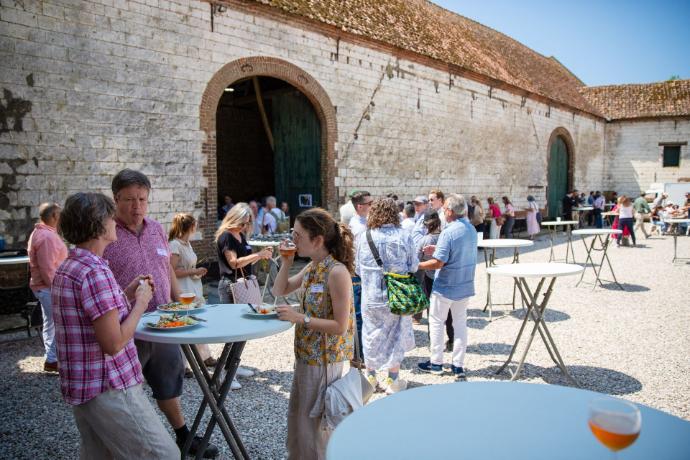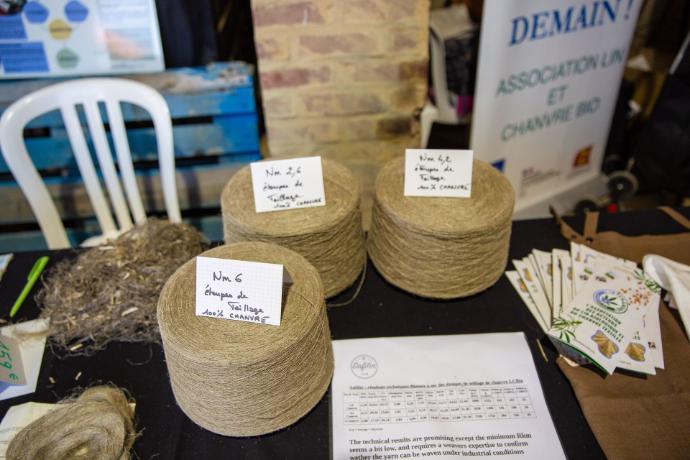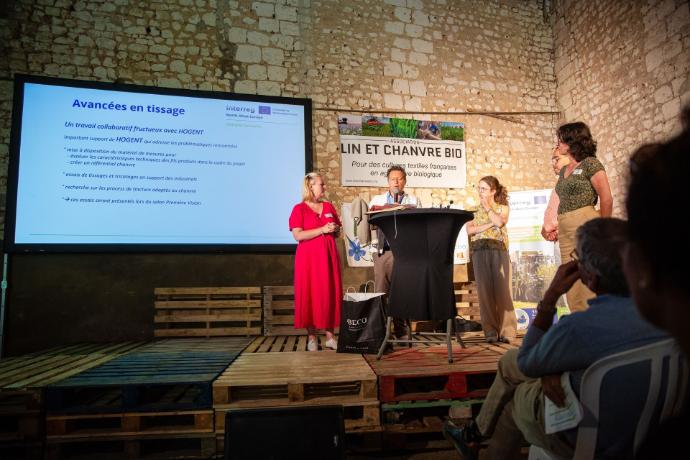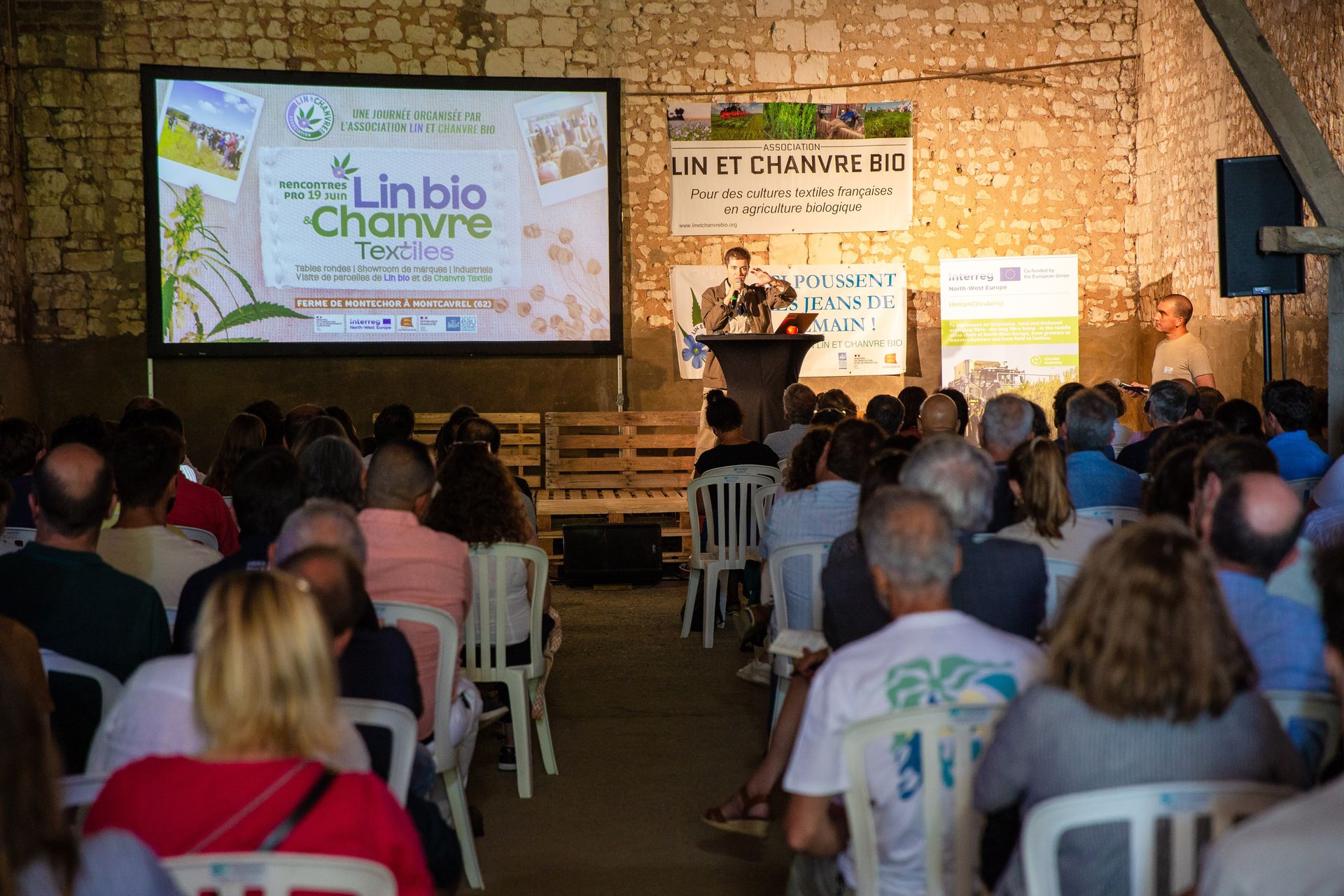On 19 June 2025, the organisation Lin et Chanvre Bio hosted the 11th edition of its Interprofessional Meeting in Montcavrel, in the Hauts-de-France region. The event brought together key players from the natural fibre textile value chain — from farmers to clothing brands — to discuss the latest technical progress in the field, industrial innovations, and evolving market trends.
Hemp4Circularity in the spotlight
The morning featured a series of conferences centred on organic flax and long-fibre hemp. This year, a key highlight was the presentation of the European project Hemp4Circularity (H4C), which brings together 11 partners from Belgium, the Netherlands, Germany, and France.
Led by Valentine Donck (project manager of H4C and working at Valbiom), the session offered a reminder of the programme’s objectives and the role played by each partner.
Sophie Waegebaert, a researcher at Inagro, shared progress made in the field through trials carried out with farmers. She presented key data on long-fibre yields, ranging from 12% to 26% depending on the region and quality, with an average of 18% – confirming hemp’s strong potential for textile applications.
From fibre to yarn: research and innovation
Medhi Khennache, R&D manager at Safilin, a historic flax spinning company, then shared the company’s work on adapting spinning techniques to hemp, as the fibre requires different approaches than flax. Initial trials on the 2024 harvest suggest the potential for finer yarns compared to 2023, with yarn counts ranging theoretically from Nm 10 to Nm 26. This has to be confirmed once the fibres are spun. Safilin is also testing new hemp varieties to expand material sourcing options.
Libeco took over on the weaving side. Olivier Guillaume explained the adjustments needed throughout the production chain to incorporate this new fibre. Libeco successfully wove Nm 15 hemp yarn into a quality fabric, markedly different from raw flax fabric straight off the loom. Finishing and dyeing processes also revealed distinct behaviours of hemp, opening up opportunities for differentiation and complementarity between the two fibres.
Hogent, with its specialised lab, is working closely with Libeco to characterise yarns and test their transformation (weaving, knitting, dyeing). Several samples were showcased to attendees, who could appreciate the promising quality of these prototypes. Olivier Guillaume expressed strong optimism about the future of hemp textiles, noting growing interest from both consumers and brands.
Building a sustainable and visible sector
Julie Pariset, Director of Innovation and CSR at the Alliance for European Flax-Linen & Hemp, reminded participants that developing a new value chain requires time and investment. The H4C project also provides an opportunity to reflect on communication strategies that will position hemp as a distinct and innovative natural material. Sample swatches and communication tools will soon be exhibited at professional trade shows to raise awareness among fashion and interior design brands.
A field-based perspective
In the afternoon, participants visited hemp fields dedicated to textile production. This hands-on session allowed attendees to observe the crop, engage with farmers, and discuss cultivation challenges. The visit also served as a reminder of hemp’s agronomic and environmental strengths: it requires no synthetic plant protection products, has low fertiliser needs, and requires technical precision at sowing. Sophie Waegebaert was once again on hand to share her insights and guide the exchanges on site.
A collective step forward for hemp
As the Hemp4Circularity project moves forward, events like the Interprofessional Meeting on Organic Flax and Hemp provide valuable opportunities to share progress, connect with stakeholders, and strengthen the foundations of a resilient European hemp textile sector. With continued collaboration, innovation, and field engagement , hemp is steadily earning its place as a natural, high-potential fibre for the circular economy.



